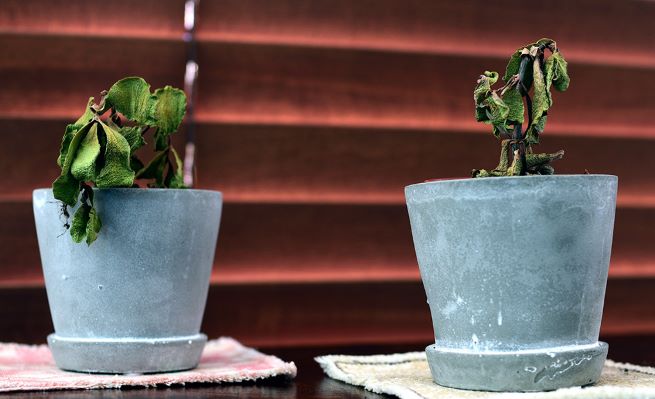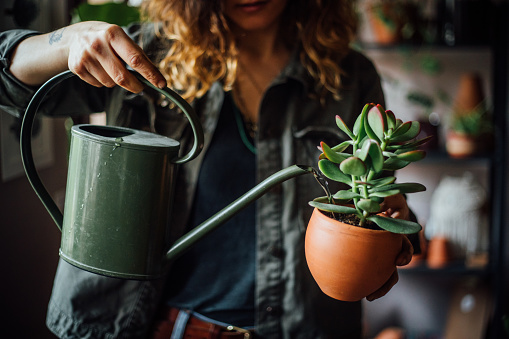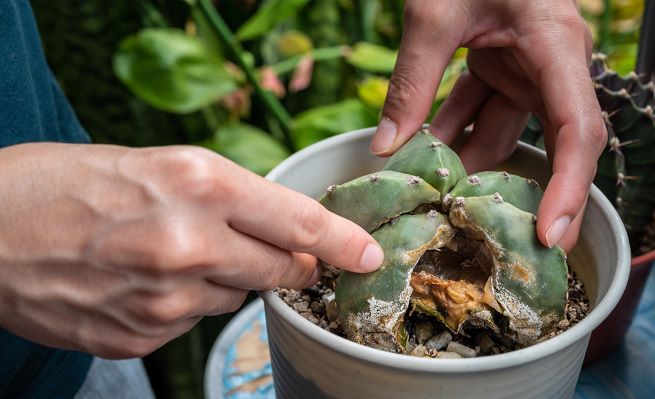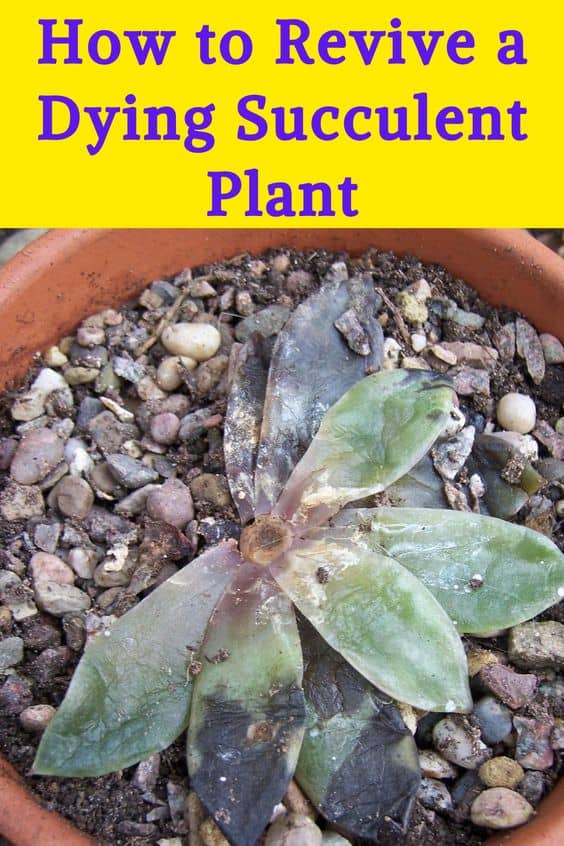Succulents are incredible plants: decorative, relatively easy to care for.
Although succulents are easy to care for, we usually make the mistake of watering the plants very little, or we over water.
This usually happens when we start in the world of succulent cultivation.
As a result, our plants will weaken and, unless we avoid it, we will lose them forever.
If we detect the problem in time and follow these tips, you can rescue your plant, before it dies.
This is our best choice to get you started with new succulents.

You may like How to Propagate Succulents
Common Succulent Problems and How to Revive a Dying Succulent Plant
The first thing to do is to see if it is weakening or not, as we can take the necessary measures as the case may be.
7 Common Signs that your Succulents Might be Dying:
- Yellow, transparent and / or soft sheets
- Closed sheets
- Fall of leaves out of season
- Wrinkled plant
- The stem or trunk feels very soft
- Black spots on the stem
- The appearance of fungi (gray or white powder)
8 Things That Can Kill your Succulent Plant
1. Excess Water in your Succulents
Now, if the leaves that have grown new in your succulent do not look very good, you will have to take note and determine what may be causing the change.
Inadequate irrigation is one of the major causes of death of succulents.
If succulent leaves turn yellow and transparent and feel moist or soft when touched, they are likely to have been watered excessively. Black spots on the leaves or the stem are a sign of rot due to overwatering and should be treated immediately.
An early sign of excess water in your succulent plants may be the ease with which the leaves fall off.
There are cases in which this occurs with just a tap.
2. Lack of Nutrients (Not Using Fertilizer)
Succulents do not need too much fertilizer, but after a long time in a pot, the soil may no longer have the nutrients the plant needs to develop properly.
In this case, we suggest you get fertilizer. We use this one on all our succulents and it’s worked well for us in the past.
If you suspect that your plant has nutritional deficiencies, you can give them a light diet during the spring and summer growing season.
But be careful not to overpay, as this can cause the plant to experience excessive growth followed by a weakening.
3. Inadequate substrate
This substrate is very important for the life of your succulents.
Succulents need a substrate with good drainage and the garden soil or a universal substrate may not be the most suitable.
When buying a substrate (soil) for your succulents, choose a specific substrate for cacti and succulents that is the one with the most appropriate composition.
You also have the option of preparing your own substrate mix at home, you just have to add it to the garden soil: sand, perlite, or pumice stone.
4. Lack of Water in your Succulents

If your succulent begins to have wrinkled leaves and become dry and crunchy, your succulents probably need water.
Most succulents revive quite quickly if they are starting to wrinkle.
However, when they get wrinkled completely, there is a chance that they will not recover.
While it is more likely, in most cases, to revive a succulent with a lack of water than an excess; Ideally, learn how to water your succulents with the right amount of water.
Knowing these signs and symptoms of irrigation problems will help you save your succulents before it is too late.
Dry lower leaves are normal in succulents, but if those that are the product of new growth and the upper leaves begin to look different, there is a possibility that your succulents are not being adequately watered.
5. Not Enough (or too much) Sunlight
Succulents love light and need approximately six hours of sunshine a day, depending on the variety. However, freshly planted succulents can’t burn under direct sunlight, so you may have to gradually introduce them to sun exposure.
To start it is better to put them in light shade or under other bushes that protect it.
When you notice symptoms of growth, you can take it to a more exposed place.
If you observe that in addition to bowing it also grows stretched, it may be a sign that you need to be in a more illuminated place.
This phenomenon is called etiolation and occurs because the plant receives poor luminosity.
It can also happen that the leaves of your succulents are burned.
This is because the plant is very exposed to sunlight.
In that case, you should reduce your plant’s sun exposure, especially in the hottest summer hours.
6. Too Much Water (Using Pots Without a Drain Hole)
It is true that succulents can live in pots without drain holes, but it is much harder to keep them alive.
Remember that succulents hate moisture and waterlogging.
When we use pots without a drainage hole, more care should be taken when watering the plant, since the substrate will take longer to dry, because the substrate has no place to remove excess water.
For this reason, I recommend using pots with holes or you can drill the pot in the bottom yourself, in case the pot you want to use does not have this hole.
If you use pots without a drain hole, be more careful when watering. Try to water the plant in the sunniest hours and make it a little less water, compared to a plant that was in a pot with drainage. And make sure you use a substrate that has good drainage and allows air to circulate.
7. Plagues and Diseases
Bacterial wilt is a disease transmitted by insects that causes the breakdown and collapse of succulents.
Cochineals are a type of pest that causes succulents to lose their health.
To treat this problem, the easiest way is to buy a specific fertilizer for this type of pest and follow the packaging specifications.
What I can recommend is that you try to buy the fertilizer with fewer chemicals you find, to avoid possible burns in the plant.
Fungal infections usually appear as small white cotton balls on the surface of the substrate and also under the leaves.
They are called dusty mold.
To eliminate the hogs of our succulents: remove the succulent from the pot and clean the plant especially the roots (remove the rotten parts), then disinfect the pot, and finally plant the succulent in the pot cpn a new substrate and with a good drainage
8. Succulent Leaves Drooping
Something that creates great confusion, is dead leaves at the bottom of a succulent. When this happens, we don’t know if it’s normal or not.
If this is your case I will explain; It is very normal to find dried leaves at the bottom of the succulent.
This is part of a plant life cycle and can often occur, depending on the type of succulents you have.
Some old and mature leaves at the bottom of the stem dry to make room for newly grown leaves.
In that circumstance, your succulent does not need special care or treatment. Simply pick up the dead leaves gently without disturbing the other living leaves.
When we have to worry is if the young leaves that come out, within a weak, dry and fall out.
If this is the case, it is important to detect what is causing the new leaves to grow weak, as this can be caused by several factors; excess water or lack of water, lack of sun, inadequate substrate, etc.
As a reference, the new leaves must be firm and new growth stems must grow where the dried ones used to be.
How to Save a Sick Succulent from Excessive Watering

The first thing you should do is reduce irrigation or see if it is necessary to change the substrate, for one that has better drainage.
If the stem is affected, which is detected because black spots of rot are seen on it, you should cut the top of the plant and then plant it in a substrate so that you can get a new and healthy plant.
Be sure to remove any areas with black spots from the plant and let a few days pass before planting to allow time to remove excess water stored inside.
You can also leave the lower part of the plant in the substrate if after removing all the rotten, there is enough aerial part that can be recovered from the root. Do not water at all until the soil is completely dry. And remember that if the substrate does not drain well you should change it.
If your plant is dying from excess water, keep in mind that if you manage to recover it you must reduce the irrigation to prevent the plant from becoming sick again.
How to Save a Sick Succulent Due to Lack of Irrigation

If, on the contrary, your succulent is dying due to lack of water, what you should do is remove it from the direct sun and put it in a semi-shade, so that the substrate does not dry out so quickly.
At the time of irrigation, add (gradually) more water.
You should gradually approach it so that your plant gets used to the new amount of water that you are going to give it.
Another very important point is you should increase the amount of water at the time of irrigation, and not the days of irrigation.
You should only water your succulents when the substrate is completely dry, especially in the winter seasons.
7 Steps to Recover a Rotten Succulent.
1. Check the plant for infected areas. Infected areas usually appear as black or dark brown spots, usually at the bottom of the plant. Other signs of rotten root, or stem, include wrinkled skin with a dark tint bordering the infected area.
2. Since you detect these infected areas, stop watering the succulent plant.
3. Remove the succulent from its pot. Clean the pot thoroughly to ensure there are no remains of the fungus. You can use the substrate to sow the plant again, but my recommendation is to change the substrate for a new one to be sure that there will be no mushroom dough.
4. Cut the infected black stem of the plant with a garden knife. Let the healthy portion of the succulent dry naturally, in direct sunlight, for several hours. If other areas of the plant show signs of rot, even if they are minimal, keep it under surveillance or remove it from the plant.
5. Using the clean or new pot, combine with equal parts of soil, coarse sand, and peat moss. Do not reuse any material used in the infected plant.
Pour about 5 cm of the mixture into the pot. Place the freshly cured succulent in the pot with the roots on the top of the soil. Fill the pot with the soil mixture until it reaches the base of the stems.
6. Firmly apply the soil around the plant.
Place your succulent in a bright and warm place. Succulents prefer dry climates, so they should not be placed in humid places.
7. Water the plant with enough water to moisten the soil until a week after replanting it. After the soil has dried completely, you can water it more thoroughly.
